|
|
|---|
| Macintosh PowerBook |
| Models: | PowerBook 100, 140, and 170 |
| Introduced: | October 1991 |
| Discontinued: | October 1992 |
| Price: | US$2,299 - $4,599 |
| CPU: | Motorola 68HC000 @ 16MHz |
| RAM: | 2MB minimum, 8MB maximum |
| Display: | 640 X 400 monochrome LCD |
| Ports: | ADB, 1 or 2 serial, HD |
| Storage: | 1.4MB 3.5-inch floppy drive |
| 20MB or 40MB SCSI hard drive |
| OS: | Mac OS 7.01 - 7.6.1 |
| |
|---|
|
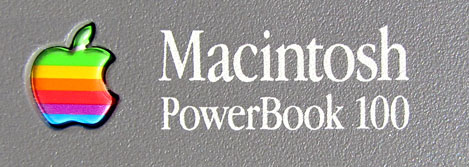
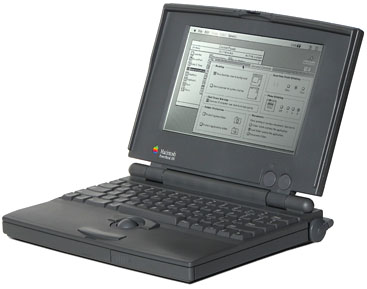
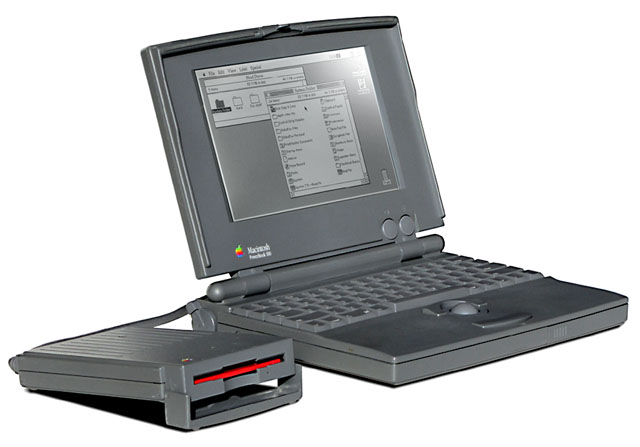
The Apple Macintosh Portable from 1989 was Apple's first portable computer, but it was a huge, heavy,
beast of burden, weighing in at over 15 pounds.
Hoping to redeem their reputation, Apple contracted with Sony to miniaturize the Macintosh Portable -
the resultant PowerBook 100 is an improvement in almost every way - smaller, lighter, and cheaper, while maintaining
indentical functionality.
At the COMDEX / Fall computer trade show in October 1991, Apple introduced their new PowerBook series of notebook
computers to the public, including the Apple-designed mid-range PowerBook 140 and high-end PowerBook 170.
The trend-setting PowerBooks were the first notebook systems to place the keyboard towards the back, behind a palmrest and trackball
in the front, pioneering notebook ergonomics which all subsequent systems were to follow.
Fabulously portable, the PowerBook 100 was the most compact Apple computer for the next decade, partially due to the lack of
internal floppy drive, until the Titanium PowerBook came out in 2001.
Like the original Macintosh Portable, the PowerBook also uses an internal SCSI harddrive, which while considerably
faster then the typical PC IDE hard drive, probably costs twice as much.
They also have in common the "SuperDrive" floppy drive, which allows the PowerBook to read and write standard
MS-DOS 1.44MB floppy disks.
As the first really useful portable Macintosh computers, the PowerBooks
were a great success for Apple, selling over 100,000 in the first three months alone, and sales in excess
of $1 billion in the first year.
| | PowerBook 100 | PowerBook 140 | PowerBook 170 |
| Designation | Most Affordable | Mainstream | High Performance |
| Price | $2,499 | $2,899 to $3,199 | $4,599 |
| Processor | 68HC000 @ 16MHz | 68030 @ 16MHz | 68030 @ 25MHz
68882 FPU |
| Hard drive | 20MB or 40 MB SCSI | 20MB or 40MB SCSI | 40MB SCSI |
| LCD Display | 9-inch passive | 9.8-inch passive | 9.8-inch active-matrix |
| Floppy drive | External (optional) | Internal | Internal |
| Batteries | Lead acid | NiCad | Nicad |
| Weight | 5.1 pounds | 6.8 pounds | 6.8 pounds |
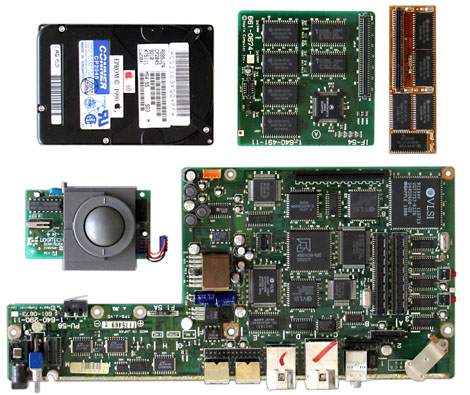
Apple PowerBook 100
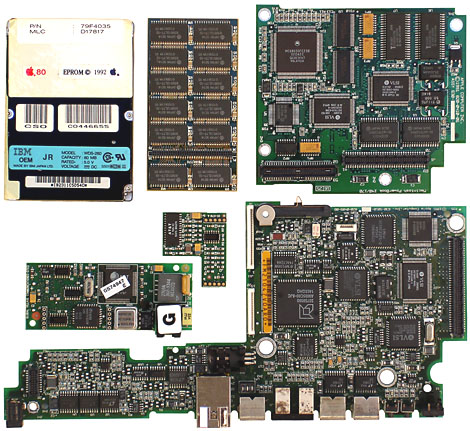
Apple PowerBook 170
|
|---|
Partial History of the Apple Computer Corporation |
- 1973: Stephen Wozniak joins HP.
- 1976: Wozniak proposes that HP create a personal computer. He is rejected.
- 1976: March - Steve Wozniak and Steve Jobs finish work on a computer circuit board, that they call
the Apple I computer.
- 1976: April - Steve Jobs and Steve Wozniak form the Apple Computer Company, on April Fool's Day.
- 1976: July - The Apple I computer board is sold in kit form, and delivered to stores by Steve Jobs
and Steve Wozniak. Price: US$666.66.
- 1976: August - Steve Wozniak begins work on the Apple II.
- 1976: October - Wozniak remains at HP, but is soon convinced that he should leave and join Apple Computer.
- 1976: December - Steve Wozniak and Randy Wigginton demonstrate the first prototype Apple II at a
Homebrew Computer Club meeting.
- 1977: March - Apple Computer moves from Jobs' garage to an office in Cupertino.
- 1977: April - Apple Computer delivers its first Apple II system, for $1295.
- 1977: May - 10 months after its introduction, 175 Apple I kits have sold.
- 1978: Apple Computer begins work on an enhanced Apple II with custom chips, code-named Annie.
- 1978: Apple Computer begins work on a supercomputer with a bit-sliced architecture, code-named Lisa.
- 1979: June - Apple Computer introduces the Apple II Plus, with 48KB memory, for US$1195.
- 1979: September - Apple Computer sells 35,000 Apple II computers for the fiscal year.
- 1979: October - 2.5 years after the introduction of the Apple II, 50,000 units have been sold.
- 1979: Apple Computer begins work on "Sara", the code name for what will be the Apple III.
- 1980: May - Apple Computer introduces the Apple III.
Price ranges from US$4500 to US$8000.
- 1980: September - Apple Computer sells over 78,000 Apple II computers during the fiscal year.
- 1980: Apple Computer ships the first Apple III units in limited quantity.
- 1980: Apple Computer begins project "Diana", which would become the Apple IIe.
- 1981: September - Apple Computer introduces its first hard drive, the 5MB ProFile, for US$3499.
- 1981: Apple Computer officially reintroduces the Apple III, with improved software and a hard disk.
- 1982: Sales of Apple II Plus to date: 45,000.
- 1982: Sales of all Apple II systems to date: 750,000.
- 1982: Apple Computer becomes the first personal computer company to reach US$1 billion in annual sales.
- 1982: Franklin Computer Corp. unveils the Franklin Ace 1000,
the first legal (at the time) Apple II clone.
- 1983: January - Apple Computer officially unveils the Lisa computer.
Its initial price is US$10,000. During its lifetime, 100,000 units are produced.
- 1983: January - Apple Computer introduces the Apple IIe for US$1400.
- 1983: June - The one millionth Apple II is made.
- 1983: June - Apple Computer begins shipping the Lisa.
- 1983: June - Video Technology introduces the Laser 3000, an Apple II workalike microcomputer.
- 1983: June - Unitronics shows the Sonic, an Apple II workalike microcomputer.
- 1983: July - Apple Computer officially begins marketing the Lisa computer.
- 1983: December - Apple Computer introduces the redesigned Apple III as the Apple III+, for US$3000.
- 1983: December - Apple unveils the new Macintosh to the press.
- 1983: Franklin shows an operating Franklin Ace 1200 Apple II compatible for US$2200.
- 1984: January - Apple releases a new version of the Lisa computer, the Lisa 2. It uses all new software,
as well as the Macintosh operating system.
- 1984: January - Apple Computer's Steve Jobs introduces the Apple Macintosh.
- 1984: April - Apple Computer unveils the
Apple IIc, priced at US$1300.
- 1984: April - Apple Computer retires the Apple III and Apple III+, with only 65,000 units sold in total (90,000 made).
- 1984: May - Apple Computer announces that 70,000 Macintosh computers have been shipped in the first 100 days since its announcement.
- 1984: September - Apple Computer introduces the Macintosh 512K for US$3200.
- 1984: November - The 2 millionth Apple II computer is sold.
- 1984: Apple sells the 250,000th Macintosh system.
- 1985: January - Apple Computer officially renames the Lisa the Macintosh XL.
- 1985: March - Apple Computer introduces the Apple Enhanced IIe.
- 1985: April - The Macintosh XL (formerly called Lisa) is dropped from Apple Computer's product line.
- 1986: January - Apple Computer introduces the Macintosh Plus. Price is US$2600.
- 1986: April - Apple Computer discontinues the original Macintosh and the Macintosh 512K.
- 1986: April - Apple Computer introduces the Macintosh 512K Enhanced, for US$2000.
- 1986: July - Apple Computer discontinues the Macintosh XL.
- 1986: September - Apple Computer introduces the Apple IIGS,
with the Apple 3.5 drive, for US$1000.
- 1987: January - Apple Computer introduces the Apple Platinum IIe.
- 1987: March - Apple Computer introduces the open architecture Macintosh II, US$3900.
- 1987: March - Apple Computer makes its 1 millionth Macintosh personal computer.
- 1987: March - Apple Computer introduces the expandable Macintosh SE for US$2900.
- 1987: March - Apple Computer discontinues the Macintosh 512K Enhanced.
- 1987: Apple Computer begins shipping the Macintosh II.
- 1988: September - Apple Computer introduces the Apple IIc Plus for US$1100.
- 1988: September - Apple Computer introduces the Macintosh IIx computer, base price is US$7770.
- 1989: January - Apple Computer introduces the Macintosh SE/30, US$6500.
- 1989: September - Apple Computer announces the Macintosh Portable, for US$6500.
- 1989: September - Apple Computer announces the Macintosh IIci, for about US$8700.
- 1991: February - Apple Computer discontinues the Macintosh Portable.
- 1991: October - Apple Computer introduces the Macintosh PowerBook line of computers.
- 1992: October - Apple Computer discontinues the first generation of Macintosh PowerBook computers.
Source:
Chronology of Events in the History of Microcomputers
| |
|---|
|
Return to the Obsolete Technology Homepage

Copyright 2024
This page last updated on 05/08/2016 01:07:51
All logos and trademarks on this site are property of their respective owner.
|




